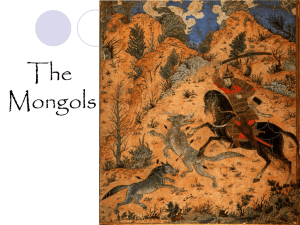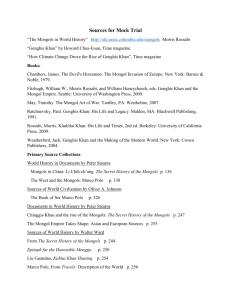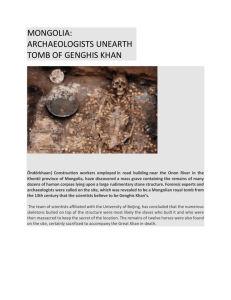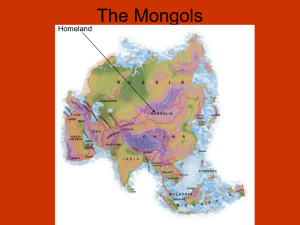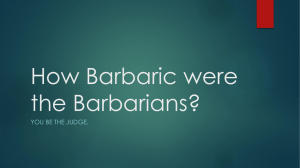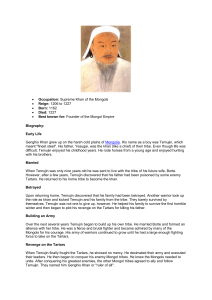Genghis Khan: (1162-1227) Sources: Most of the information we
advertisement
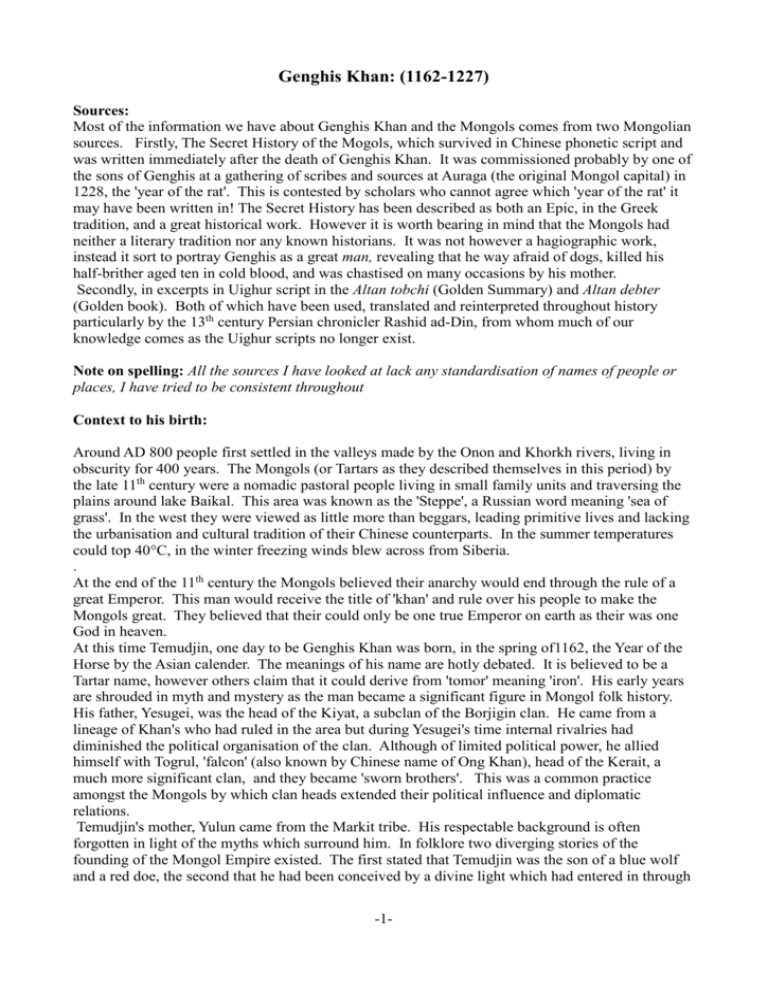
Genghis Khan: (1162-1227)
Sources:
Most of the information we have about Genghis Khan and the Mongols comes from two Mongolian
sources. Firstly, The Secret History of the Mogols, which survived in Chinese phonetic script and
was written immediately after the death of Genghis Khan. It was commissioned probably by one of
the sons of Genghis at a gathering of scribes and sources at Auraga (the original Mongol capital) in
1228, the 'year of the rat'. This is contested by scholars who cannot agree which 'year of the rat' it
may have been written in! The Secret History has been described as both an Epic, in the Greek
tradition, and a great historical work. However it is worth bearing in mind that the Mongols had
neither a literary tradition nor any known historians. It was not however a hagiographic work,
instead it sort to portray Genghis as a great man, revealing that he way afraid of dogs, killed his
half-brither aged ten in cold blood, and was chastised on many occasions by his mother.
Secondly, in excerpts in Uighur script in the Altan tobchi (Golden Summary) and Altan debter
(Golden book). Both of which have been used, translated and reinterpreted throughout history
particularly by the 13th century Persian chronicler Rashid ad-Din, from whom much of our
knowledge comes as the Uighur scripts no longer exist.
Note on spelling: All the sources I have looked at lack any standardisation of names of people or
places, I have tried to be consistent throughout
Context to his birth:
Around AD 800 people first settled in the valleys made by the Onon and Khorkh rivers, living in
obscurity for 400 years. The Mongols (or Tartars as they described themselves in this period) by
the late 11th century were a nomadic pastoral people living in small family units and traversing the
plains around lake Baikal. This area was known as the 'Steppe', a Russian word meaning 'sea of
grass'. In the west they were viewed as little more than beggars, leading primitive lives and lacking
the urbanisation and cultural tradition of their Chinese counterparts. In the summer temperatures
could top 40°C, in the winter freezing winds blew across from Siberia.
.
At the end of the 11th century the Mongols believed their anarchy would end through the rule of a
great Emperor. This man would receive the title of 'khan' and rule over his people to make the
Mongols great. They believed that their could only be one true Emperor on earth as their was one
God in heaven.
At this time Temudjin, one day to be Genghis Khan was born, in the spring of1162, the Year of the
Horse by the Asian calender. The meanings of his name are hotly debated. It is believed to be a
Tartar name, however others claim that it could derive from 'tomor' meaning 'iron'. His early years
are shrouded in myth and mystery as the man became a significant figure in Mongol folk history.
His father, Yesugei, was the head of the Kiyat, a subclan of the Borjigin clan. He came from a
lineage of Khan's who had ruled in the area but during Yesugei's time internal rivalries had
diminished the political organisation of the clan. Although of limited political power, he allied
himself with Togrul, 'falcon' (also known by Chinese name of Ong Khan), head of the Kerait, a
much more significant clan, and they became 'sworn brothers'. This was a common practice
amongst the Mongols by which clan heads extended their political influence and diplomatic
relations.
Temudjin's mother, Yulun came from the Markit tribe. His respectable background is often
forgotten in light of the myths which surround him. In folklore two diverging stories of the
founding of the Mongol Empire existed. The first stated that Temudjin was the son of a blue wolf
and a red doe, the second that he had been conceived by a divine light which had entered in through
-1-
the roof of his mother's house and impregnated her.
Temudjin grew up on the banks of the river Onon, where Yesugei had his camp.
Around the age of eight Temudjin's father was assassinated by the Tartar's. Myth has it that he was
poisoned by his rivals after drinking with them at their camp and died upon his return home. After
this, the remainder of his family were cast out from the clan, surviving on wild plants and traversing
the wilderness.
Temudjin developed a strong personality, resourceful and determined. At sixteen, he married his
first wife Borte, a member of his mother's clan the Ongirads. Borte has been betrothed to the boy
since the age of eight, his father deeming her a suitable match. As a dowry, a black sable gown was
given to Temujin which he later offered to Toghrul in exchange for his protection and influence
uniting the Mongol clans under Temujin.
Shortly after this Borte, herself a forceful woman recorded in many paintings from this period, was
abducted by the Markit and given as wife to Chilgerboko, a member of the clan's aristocracy. The
abduction was intended as a revenge as Temujin's father had stolen Hoelun, Temujin's mother from
the Markits years previously. Despite having increased his status through his new in-laws he still
lacked troops or armed support of his own. Temujun approached his uncle-the man to whom his
father had sworn allegiance, for help in recovering Borte. Together with Temujin's childhood
friend, Jamuka and an ally he had gained in his years in the wilderness, Boorchu, a three army
attack defeated the Merkets and recovered Borte, who soon gave birth to a child, Jochi ('visito' or
'guest') believed to be an illegitimate son from her time in captivity.
After this, the clan lived with Jamuka's clan for a while, moving from a hunters existence in the
mountains to a herder society on the steppe, until their friendship turned into rivalry and they split
in 1181.Temujin now seemed determined to become a warrior leader of his own and spent the next
decade assimilating neighbouring clans with his own, offering then fierce loyalty in return for their
support. Similarly, Temujin's clan acted as a vassal of Togruhl's, successfully completing military
campaigns in his name, such as against the Jurkin. Political survival on the steppe was a process of
careful military strategy-playing the various weaker clans off against each other and ensuring none
developed an overwhelming influence. Temujin recognised that whilst this system existed these
clans were destined to remain vassals of external political rulers. He knew that to overthrow this
system he needed to kill military leaders after they were defeated, and absorb the civilians into his
own clan, thus reducing the opposition and strengthening his own following. Interestingly, Temujin
adopted a son from each clan he defeated, symbolising his intent to unite the tribes of the region
into a greater political entity.
Temujin had proven himself a strong leader and had successfully
protected his new clan. Rivalry with Jamuka had intensified, but the
latter had discredited himself amongst the Mongols after reportedly
boiling seventy captives alive, thus destroying their soles and
annihilating them. Conversely, Temujin had developed a small, but
loyal following and was looked on much more favourably by the
small scattered clans.
Despite this however, Tonghul continued to play the rivals off each
other; refusing to acknowledge full support for Temujin by rejecting
an offer of marriage between Temujin's first child Jochi and Toghul's
daughter. Temujin's success on the steppe concerned the blood
brother of his uncle, and shortly after the failed marriage
negotiations, Togul plotted to annihilate the clan. Successfully
gathering a band of supporters from all over the region, Temujin
defeated the old Khan with an army which transcended race and
-2-
ethnicity. This was a major feat for the Temujin, who had freed the Mongol tribes from a relentless
cycle of political disputes.
In 1195 a meeting of the plenary assembly pronounced him 'khan'. This developed into Tchingis
Qaghan, a controversial title either understood to mean 'universal ruler' or a Turkic derivation of
'oceanic sovereign'.
Like other chieftains, he owned no land, and that which he did oversee was wild, with bleak winters
and dry summers.
Over time Genghis consolidated his power in several ways. Firstly, he created the yasak- a political
and moral code which incorporated his ancestral traditions into a new, centralised system. This
centralisation was founded in the Mongols belief in one great Emperor. To achieve this Genghis
had to defeat his great helper but also his rival for power, Tughrul now proclaiming himself Khan of
the Kereits. Using a mixture of military force and diplomatic cunning, he attempted to defeat the
ageing Toghrul which he did successfully, and by 1203 Tughrul was dead.
Physical features:
The sources describe him as tall, with a noble beard and eyes like a cat's.
Personality attributes:
The Mongols gained a reputation for being physically robust, able to withstand any climate or
hardship. Genghis Khan was certainly renowned for the strength of his personality.
He was also notoriously cruel when he needed to be to achieve diplomatic ends, such as crushing
the Kereits as an example of the wrath which would be felt by those who were treacherous. By his
nature he disliked the urban culture of China and the mercantile attitude of the Islamic lands in the
West.
He was illiterate, although came to appreciate the advantage of a royal seal and the value of writing.
Genghis Khan was quick to reward merit, and his strong leadership relied on a faithful collection of
followers and warriors to whom his loyalty was absolute.
Genghis had a large family, bringing home a new wife from every campaign. Rashid, the thirteenth
century Persian chronicler maintained that Genghis had a harem of five hundred wives and
concubines. A favourite wife accompanied him on each campaign. Despite his array of women
there is no evidence that the Khan had a passionate love affair. His first wife Borte, was recaptured
from the Merkits more on a point of honour and strategic disposition than due to a long standing
affection for her.
Military expansionism:
The heart of Genghis Khan's success was his military defeats of neighbouring tribes, and his ability
to incorporate their lands into his domain, later to become the Mongol Empire. At the time of
Genghis Khan's death his army amounted to 129, 000 men, not including the tens of thousands
more operating in China. This roughly amounted to 1 in 10 men being active in the army,
illustrating the highly militarised nature of the Mongolian imperial vision.
Military Organisation:
The army was organised into units or toumen of ten, in hundreds and thousands. The smallest squad
was an arban, a unit of 10 men. Genghis successfully substituted the idea of traditional clan
solidarity for that of these fighting units, instructing the soldiers to live and fight together as
brothers. 10 arban formed a zagun, which collectively elected a leader. 10 of these companies
-3-
formed a battalion, or mingan. Ten mingan then formed a tourmen, the leader of which was
selected by the Khan. This decimalised structure is believed to have come from earlier Turkic
tribes. Genghis applied it not only to the military but across the society he ommanded.
Horsemen were split into heavy and light cavalry, the former wearing complete body armour This
meant that each soldier bore the responsibility and consequently took punishment for all deeds in
his unit. The most common weapon was the crossbow, versatile for both short and long distance
combat. Horses were also crucial, each man having at least three at any one time. Indeed horses
were central to the lifestyle of the Mongols, used for transportation, milked for food and ridden into
combat.
Under the new Mongol Empire anyone from shepherds to camel boys could advance through the
ranks to the status of general. Every healthy male between fifteen and seventy took an active part in
military service.
Many military formations were used successfully by the Khan, including the 'Tumbleweed' or
'Moving bush formation' and the 'Lake Formation'. The first involved the dispersal of arbans from
various directions silently in the pre-dawn darkness. This disorientated the enemy, making it
difficult for them to calculate numbers of the opposition. The squads then dispersed quickly,
leaving the enemy wounded and unable to retaliate. The Lake formation by contrast, entailed a long
train of troops advancing, firing arrows then falling back and dispersing as the row behind replaced
them. This created a 'ripple' effect of arrows. These two techniques would be followed by a final
formation, the 'chisel', consisting of a narrow yet deep front of men which concentrated an attack on
one point. The enemy, spreading itself thin to meet the 'Lake formation' could now quickly be
eradicated as the 'Chisel' worked its way down the line. These techniques are believed to be a
combination of traditional fighting practices and hunting methods Temujin had learned in his youth.
Genghis Khan also had a personal guard-one of the most notorious and feared military units in
history. They were as close to him as brothers and rode everywhere with him, totalling 70 in
daylight and 80 by night in its early years and reaching one thousand by the height of the Khan's
military career, led by Jebei, his 'Arrow'.
Military campaigns were carefully planned. A series of scouts were sent to check out trails, supply
depots were carefully positioned and water sources controlled. Older methods of communication
were used, such as torches, whistling arrows, smoke, flares, flags and a complex system of arm
signals, as used in hunts.
Scouts or 'arrow riders' were particularly strategic, riding non-stop for days, eating and sleeping
along the way and changing horses when they were fatigued, in order to deliver information to
armies.
The Moguls avoided large scale battles, instead operating a system of harassment to exhaust the
enemy, including placing camp fires where they had no camps and dressing straw mannequins as
soldiers. They travelled without a supply train during desert crossings, instead taking an engineer
corps which could build whatever they needed on the spot from materials available.
Genghis has been best remembered for his military genius and his innovative approach to warfare.
For example, noticing that after a victory, strict military order was often abandoned as soldiers
jostled to raid a camp, the Khan banned looting until a complete victory had been secured. Then
organised looting took place, in which the Khan himself distributed the spoils of war. Similarly,
influenced by the circumstances in which a raid had left his mother when he was a child, Genghis
ordered that a soldiers share be distributed to each widow and orphan of a soldier. This inspired
confidence in the poorest members of the now assimilated tribe and in turn loyalty for their new
clan head.
-4-
Map (http://en.wikipedia.org/wiki/Genghis_Khan)
Military Campaigns:
These began in 1202 when he vowed to conquer and crush the Tartars, those who had killed his
father, escalating over the next twenty years to crush rivals on the steppe, from the Kereyid to the
Naimen.
Jamukha, (chief of the Jadaran, a peer and reported blood brother of Genghis-see above) was finally
defeated in 1205 when a couple of his dissenting followers took him hostage and brought him to the
Mogul Khan. Disapproving of such disloyalty, even to an enemy, Genghis executed the kidnappers
and tried to renew diplomatic relations with Jadaran. Refusing, the Khan was left only with the
option of punishing him, but allowed his old blood-brother one last request. Choosing not to die
through bloodshed, Genghis respected his wishes and had him wrapped in a thick carpet and
crushed to death before burying him.
Having done this, Genghis gained and secured the land which would become Mongolia. By 1206
the assembly had declared him Khaghan or emperor, king of king's and ruler of the Steppes. The
use of this title is disputed however, some claim this was added posthumously, others that it was
attached at the time but not used by Genghis, who remained conscious of his origins and of the need
to remain attached to rather than aloof from his subjects.
With his sovereignty secured, Genghis embarked on an aggressive expansionist foreign policy. In
1207 he sent his son Jochi to suppress Siberia whilst he crossed the Gobi desert to attack the
Tangut, aided by the rivals of this region, the Qarluk and the Uighur. This battle, unlike those the
Mongols were used to was a siege of the city and required a change of military tactics. The sources
tell how Ghenghis cunningly negotiated with the enemies within the walled city, stating if he
received a tribute of one thousand cats and ten thousand swallows his army would retreat. The
tribute received, the Khan then ordered his army to tie cotton to the creatures which were then set
-5-
alight and sent back into the city, throwing the enemies into disarray as the city blazed.
In 1211 Genghis had set his sights on China after hearing from messages in Pekin that a new Kin
emperor Wei-Shao was installed, and declared war on the Jin Kingdom in the North of the country.
The Lhan had prepared well, drawing an army from a 600, 000 square mile radius of his domains
and mobilised all his allies. The Great Wall of China, 2,300 miles of defence, made warfare
difficult, yet Genghis took advantage of this slow progress by concentrating efforts on Manchuria
also. By 1215 Genghis had overwhelmed the great city of Peking (today Beijing).
With his position in the East stable, Genghis Khan turned his attentions to the West. In 1218-9 he
gathered 156, 000-200, 000 troops to attack the Empire of Iran. Under Ala as-Din Muhammad, the
Iranian Empire included Afghanistan and Sagdiana yet was overstretched and consequently weak
enough for an attack by the imperialist Mongols. By 1220 Khan entered Samakand and vanquished
the city, sparing only artisans and Holy men. Within the next couple of years a huge offensive on
Eastern Iran and Afghanistan had been launched, wiping out cities and populations in their wake.
Despite an imperial framework spanning Asia East to West, Genghis Khan was a seasoned warrior
and tactician and knew his limits, deciding against a campaign against the highly complex Indian
principalities to the South of his Empire.
In 1223 an attack had been launched on Multan in Pakistan, yet the heat and difficult, mountainous
terrain had proved overwhelming, and the Mongol armies had retreated.
In the North, West of their territories, the Mongols now turned attention to the Georgian warriors,
then at the height of their glory under Queen Thamar. Victorious, Genghis's armies now emerged
into what is now the Ukraine which was in the hands of the Kipchak Turks. Now began the
tatartchina, the subjugation of the Russians by the Tartar's from the May of 1222.
By the time of its completion, Jebei, one of the Khan's most successful warriors and Subotai had
travelled 12,500 miles in 4 years and vanquished 5 great peoples.
Genghis Khan launched one last campaign as his health faded. In the winter of 1225-6 he crossed
the Gobi desert to march against the Tangut, dying as he saw them slaughtered by his armies in
1227. He was almost 70. His body was marched back to his homeland in Mongolia by his army and
buried anonymously in the soil of the steppe, no plaque or tombstone marking his grave. The area
surrounding the secret grave, the Ikh Khorig (Great Taboo) was then sealed off, only members of
his family and an army trained to kill intruders could enter the area. It remained this way for almost
800 years.
Political administration:
In the hostile environment of the Mongolian plains, Genghis Khan brought a new componentdiscipline.
Although more than competent in warfare, the Mongols had little experience in governance,
essential to the sustained order of their new territories. Quickly, the Mongols recruited foreigners as
bureaucrats, initially from the Tangut of the South, who had adopted a complicated script from the
Chinese, also from the Uighurs and Khitans. As the empire expanded this came to include Iranian's,
Chinese and Syrian's. By 1220 in Sogdiana Genghis had installed offices to maintain records,
establish a census, levy taxes and recruit soldiers and workers.
The census was important in establishing and consolidating the boundaries of each tribes suzerainty.
Genghis Khan fostered peace through increased communication and negotiation across his
territories. In the early 1220's he forged paths through the previously inhospitable ranges of
Afghanistan and Khorasan, aiming to placate the rebels by reaching them.
-6-
Equality before the law was equal, regardless of social standing, and thus the subjects of the Empire
were in theory able to keep check of corruption or misappropriation of funds.
Law:
Together with his Uighur advisor Tatatungo Genghis Khan, shortly after becoming sovereign,
produced the Yasak, a codified law which applied indiscriminately to all Mongols. This is also
know as The Great Law of Genghis Khan, the most important of which was the belief in equality
before the law. Unlike many great law codes in history, this one did not claim authority from God,
but was a deliberate attempt to consolidate the traditions and customs of the herding tribes of the
region, whilst eradicating the aspects which had made these tribes so divided.
For example, the kidnapping of women as brides was outlawed, perceived by the Khan as a
fundamental source of animosity amongst tribes.
This law code included both matters of the state such as a decree of the death penalty for any man
found in communication with a foreign monarch, to simple measures such as prohibiting cattle
drinking from wells. There were also some general principles such as respecting and upholding
religious toleration. Similarly, slavery was outlawed for any Mongol.
Similarly, Genghis defined the role of women in society through recognising their rights and duties
before the law. Women became responsible for familial possessions, freeing up men for war and
combat training.
The yasak bound the Mongul people into a cohesive unit, making one last provision, that on the
death of the Khaghan, the princes of the family should gather together and choose a successor.
This period is commonly thought of as a time of peace across the region, when banditry was
seriously depleted, and is attributed to Genghis Khan and the yasak.
Religious beliefs:
The Mongols were practitioners of shamanism. They believed in a single God- Tengris, whose
power manifested through secondary divinities on earth and could be communicated with through
magic and mystical means. This was the role of the shaman, an intermediary between man and the
gods. Mongols turned to the Shaman on all important occasions, to give advice about the future,
such as the fate of a new born child, to pacify against evil spirits, as master of the ceremonies at
feats and to prevent droughts and storms, and crucially, to achieve military success.
Under Genghis Khan the most influential Shaman amongst the Mogols was Kokochu, the son of
Yisugei's servant who had saved Genghis' life when he was a boy.
They mostly rejected world religions, although they tolerated them and in particular instances
converted.. Interdenominational conferences were held, Buddhism and Christianity allowed to
flourish. To remote all religions, the Khan exempted all religious leaders from taxation and public
service.
This toleration extended also to ethnicity. Although the Mongol race was effectively created over
this period, it was not exalted above other races. Indeed, in the Golden Horde particularly the
Mongols became largely Turkified. Nowhere did they impose their own language universally.
Legacy of Genghis Khan:
Conscious of the need for strong leadership after his death, the Khan divided his Empire into
several Khanates between his four sons, Ogedei, Chagatai, Tolui and Jochi (although Jochi, his first
born, died a few months before the Khan himself and so his lands were split between his sons, Batu
and Orda). Ogedei was designated Great Khan, and the others were to be subordinate to him. For
more on this see Genghis' Successors page.
-7-
The most important aspect of Genghis' rule was his ability to unify, organise and discipline the
fragmented and anarchic Mongol nation.
Trade increased personal as well as state wealth, and for the majority of people a better standard of
life was enjoyed, with gold embroidered clothes and a surplus of food much of which traversed the
plains and was brought from the corners of the empire.
Migration of traders also brought new skills and crafts such as silk production to the Mongols.
The penalty for this increased prosperity came in the form of a highly militarised state, in which a
large proportion of the male population was engaged in warfare, often posted out to other parts of
the empire.
Similarly, taxation took its toll on the ordinary people who often supported an extensive
bureaucracy with a surplus of food and goods and crucially horses and supplies for the courier
service.
Gradually, the constraints of military organisation began to erode the freedom of the Mongol
traditional way of life.
A class of bureaucrats and educated men developed, often marked out from society by their ability
to read and write in the Uighur script.
The severity of law and punishment brought a certain security in public and private life to
Mongolians, which in turn attracted greater international trade.
Regionally, Genghis transformed the small civilizations which characterised the region and began
the creation of nations-large polities and social organisations. He created the trade and
communication links between Europe and China, a crucial moment in world history.
Importantly, the legacy of the Empire has been politicised by posterity. In the 14th and 15th
centuries, The Mongols were viewed in Europe as proponents of civilization, dispersing language,
religion, architecture and technology around the world. By the 18th and 19th centuries the Mongols
had been reconfigured as barbarous, lusting only gold, women and blood. Similarly, the advent of
scientific methods and an obsession with eugenics, led Western Europe to consider the Mongols a
backwards, genetically retarded race.
The man himself has become Divine in Mongolian history, illustrated best by the 'Mausoleum of
Genghis Khan' ('Lords Enclosure'), a shrine in the province of Inner Mongolia.
Many have argued that Genghis is THE most important man in history, transcending the likes of
Columbus and Vasco de Gama, who were only encouraged to the East for its wealth as reported by
travellers such as Marco Polo, who had recorded the treasures of the Great Empire.
There has also been much speculation regarding the genetic legacy of the leader. DNA studies have
suggested that hundreds of thousands of the population of central Asia could be descendants of the
man, who could have had as many as 200 children.
-8-
Mongol Empire in 1227, at Genghis Khan's death. (http://en.wikipedia.org/wiki/Genghis_Khan)
Genghis Facts:
Genghis conquered more land than any other individual in history: 11-12 million square
miles at its zenith.( roughly the size of Africa)
The Mongol army subjugated more people in 25 years than the Roman army did in 400
Genghis was afraid of dogs as a child, according to The Secret History.
Genghis created the first international postal system
The last ruling descendent of Genghis was Alim Khan, emir of Bukhara, who remained in
power in Uzbekistan until 1920.
The Mongols are not renowned for creating great buildings, castles or palaces, but Genghis
probably built more bridges than any other leader in history.
Geoffrey Chaucer devoted the longest story of The Canterbury Tales to Genghis Khan.
Genghis Khan refused to sit for paintings, the only images of the Khan in circulation today
being posthumous Chinese paintings.
At birth, Genghis is reported to ave held in his right hand a blood clot from his mother's
womb. This has been interpreted by the Mongols as a sign of an eventful life, disputably a
curse or an omen.
None of Genghis's generals deserted him in six decades as a warrior, nor did the Khan
punish any.
Summary Timeline:
1155-1167—Temüjin born in Hentiy, Mongolia.
at the age of nine—Temüjin's father Yesükhei poisoned by the Tatars, leaving him and his
family destitute
c. 1184—Temüjin's wife Börte kidnapped by Merkits; calls on blood brother Jamuka and
Wang Khan (Ong Khan) for aid, and they rescued her.
c. 1185—First son Jochi born, leading to doubt about his paternity later among Genghis'
children, because he was born shortly after Börte's rescue from the Merkits.
1190—Temüjin unites the Mongol tribes, becomes leader, and devises code of law Yassa.
1201—Wins victory over Jamuka's Jadarans.
1202—Adopted as Ong Khan's heir after successful campaigns against Tatars.
1203—Wins victory over Ong Khan's Keraits. Ong Khan himself is killed by accident by
allied Naimans.
1204—Wins victory over Naimans (all these confederations are united and become the
Mongols).
1206—Jamuka is killed. Temüjin given the title Genghis Khan by his followers in Kurultai
(around 40 years of age).
1207-1210—Genghis leads operations against the Western Xia, which comprises much of
northwestern China and parts of Tibet. Western Xia ruler submits to Genghis Khan. During
this period, the Uyghurs also submit peacefully to the Mongols and became valued
administrators throughout the empire.
1211—After kurultai, Genghis leads his armies against the Jin Dynasty that ruled northern
China.
1215—Beijing falls, Genghis Khan turns to west and the Khara-Kitan Khanate.
1219-1222—Conquers Khwarezmid Empire.
1226—Starts the campaign against the Western Xia for forming coalition against the
-9-
Mongols, being the second battle with the Western Xia.
1227—Genghis Khan dies leading fight against Western Xia. How he died is uncertain,
although legend states that he was thrown off his horse in the battle, and contracted a deadly
fever soon after.
References:
Peter Brent, 'The Mongol Empire' London, Weidenfield and Nicholson.1976
Jean-Paul Roux 'Genghis Khan and the Mongol Empire' New York, Abrams Publishing. 2003
Paul Ratchnevsky 'Genghis Khan: His life and legacy' Oxford, Blackwell. 1992
Jack Weatherford, 'Genghis Khan and the making of the Modern World'. New York, Three Rivers
Press. 2004
John Mann, 'Kublai Khan: The Mongol King who remade China'. London, Bantam. 2006.
' Genghis Khan: Life, death and resurrection'. London, Bantam. 2004.
http://en.wikipedia.org/wiki/Genghis_Khan
'The religion of Genghis Khan' E. Dora Earthy. Numen, vol,2 No. 3 1955. Available on jstor, short
summary of religious beliefs and social divisions in Mongol Empire.
-10-


